
Winburg
 A town in the Free State, next to the N1, coming from Bloemfontein it is 115km to Winburg. It's geo-position: 28.5188°S, 27.0117°E and 1433m a.m.s.l.
A town in the Free State, next to the N1, coming from Bloemfontein it is 115km to Winburg. It's geo-position: 28.5188°S, 27.0117°E and 1433m a.m.s.l.
History
Sometimes called the oldest town in the Free State, but this is if one ignores Philipollis in the Southern Free State. That one started as a mission station already in 1824, some years before the Voortrekkers arrived in the Free State.
The area between the Vet- and the Vaal river was bartered by Hendrik Potgieter from the Bataung chief Makwana for 42 head of cattle. With the first treks the area became a focus point from which some of the Voortrekkers would go east and north. The need for a town had become a necessity, but where was it going to be. A dispute arose which was settled by a referendum amongst the trekkers towards the end of 1841. A town was established in 1842. Where the name originates from is not very certain. The most common explanation is that it is from winning the battle with the Matabele in 1837 to the north of the Vaal and thus removing a threat from the settlement.
The town was declared a municipality in 1872.
Churches
NG church

 The formation of the congregation of Winburg goes back to 1840. At that time the area of the Free State, the area over the Vaal and Natal were all part of the republic of Natalia, with the administrative centre being in Pietermaritzburg. The only minister they had was Daniel Lindley, a Presbyterian missionary from America (USA).
The formation of the congregation of Winburg goes back to 1840. At that time the area of the Free State, the area over the Vaal and Natal were all part of the republic of Natalia, with the administrative centre being in Pietermaritzburg. The only minister they had was Daniel Lindley, a Presbyterian missionary from America (USA).
The foundation stone for the present church was laid by the president of the Free State MT Steyn on 20 Jan 1899. Work on the building was interrupted by the Anglo Boer War. It was complete enough that it could be used as a shelter for some of the families who's head was on commando and as a hospital. Construction re-commenced after the war and the church was inaugurated in March 1904.

 An inspiring building in a neo-Gothic style, it was designed by the architect brothers JH and AE Till. The same architects were also responsible for the design of the three English churches in Kroonstad, the Methodist, the Anglican and the Presbyterian (they would most likely object to be called English, being of Scottish origin) churches.
An inspiring building in a neo-Gothic style, it was designed by the architect brothers JH and AE Till. The same architects were also responsible for the design of the three English churches in Kroonstad, the Methodist, the Anglican and the Presbyterian (they would most likely object to be called English, being of Scottish origin) churches.
NG church Rietfontein
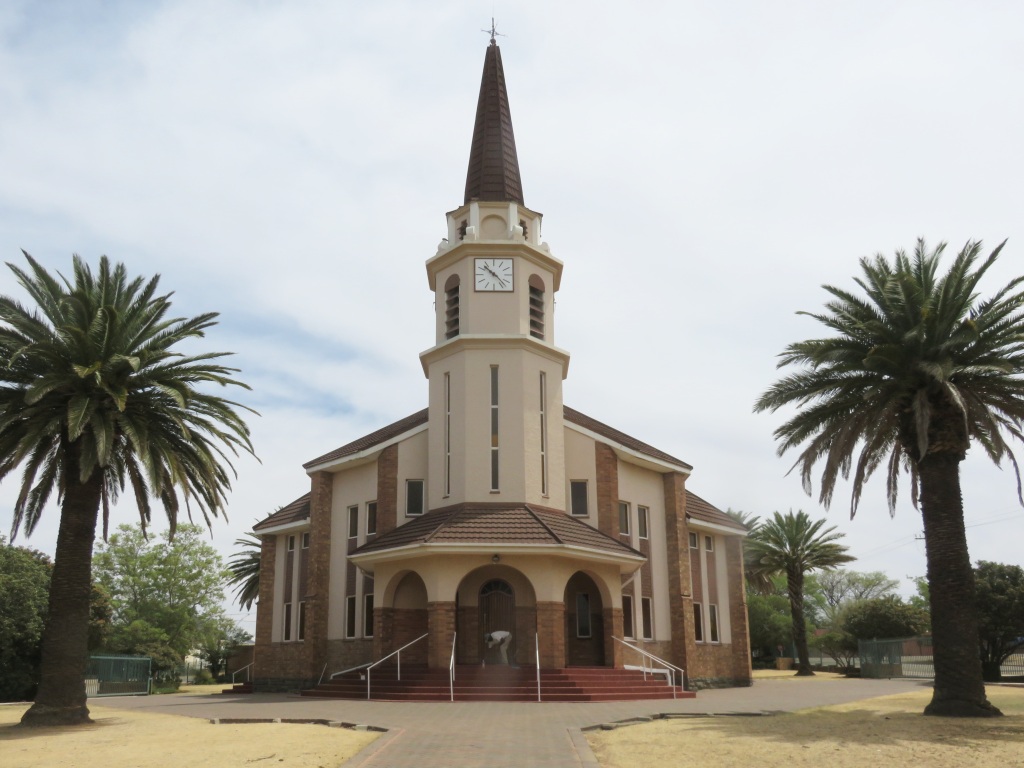 Another NG church only two blocks away from the big church, I thought this strange. It was introduced to me as the rebel church. And that is the story, it's formation goes back to the 1914 rebellion. That was the rebellion against South Africa declaring war on Germany. It led to armed conflict with a major battle fought between the rebels and the South African army near the town at Mushroom Valley.
Another NG church only two blocks away from the big church, I thought this strange. It was introduced to me as the rebel church. And that is the story, it's formation goes back to the 1914 rebellion. That was the rebellion against South Africa declaring war on Germany. It led to armed conflict with a major battle fought between the rebels and the South African army near the town at Mushroom Valley.
The aftermath of this was a request by the church council that the rebels should resign as elders from the council. It eventually led to a group leaving the congregation to form a new one they called Rietfontein. Named so after the farm adjoining Winburg.
Initially they held church services in the town hall, in 1919 they built a basic church. 1941 they had enough money collected to build the present church on the same terrain. The architect was Gerard Moerdyk.
Cemeteries
Voortrekker grave yard
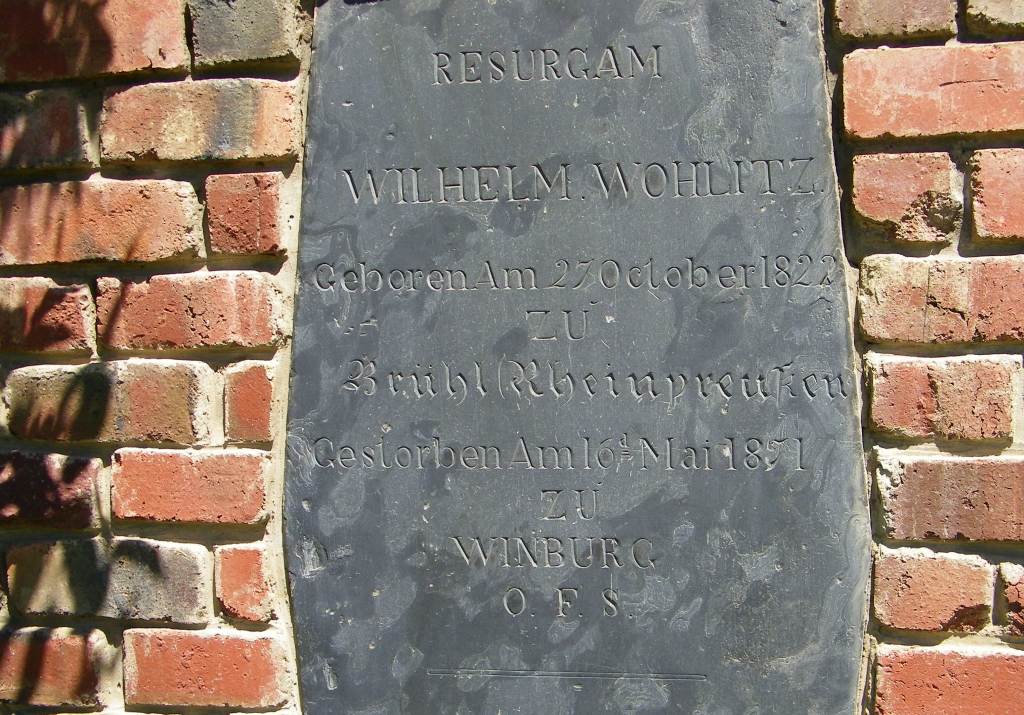 A block away from the church square is the Voortrekker graveyard. It is the oldest of the graveyards of Winburg. There are only a few marked graves, the oldest grave stone is that of Hester Chatarina Janse van Rensburg born Meyer in Mossel Bay in 1816, died in Winburg 1855. The gravestone that drew my attention is that of Wilhelm Wohlitz who was born in Brühl (Rhein Preußen) on the 27 October 1822, he died in Winburg on the 16 May 1871. Brühl is a small town near Colonge on the Rhein. In the Index of Names for "Deutsche Wanderung", he is listed as a Verwaltungsbeamter, that is a administration officer. I presume he worked for the municipality.
A block away from the church square is the Voortrekker graveyard. It is the oldest of the graveyards of Winburg. There are only a few marked graves, the oldest grave stone is that of Hester Chatarina Janse van Rensburg born Meyer in Mossel Bay in 1816, died in Winburg 1855. The gravestone that drew my attention is that of Wilhelm Wohlitz who was born in Brühl (Rhein Preußen) on the 27 October 1822, he died in Winburg on the 16 May 1871. Brühl is a small town near Colonge on the Rhein. In the Index of Names for "Deutsche Wanderung", he is listed as a Verwaltungsbeamter, that is a administration officer. I presume he worked for the municipality.
Old cemetery

 The cemetery is at the edge of town, it is not maintained and left to the environment. The picture was taken in 2012, it has further deteriorated since.
The cemetery is at the edge of town, it is not maintained and left to the environment. The picture was taken in 2012, it has further deteriorated since.
This gives me the opportunity to show off one of my "lucky shots" I took during the first visit to town in 2012. As a group of photographers we decided to go up to the cemetery at night to take pictures of gravestones by torch light. The way this is done is to put the camera on a tripod, open the shutter, and paint the object with torch light and then to close the shutter. And here is my lucky shot from that endeavour.  Notice the faint little cross in the top right corner? It looks like a spook, but it is not. Whilst I was busy on my picture a fellow photographer was also lighting up at an other grave and this gave me this double image.
Notice the faint little cross in the top right corner? It looks like a spook, but it is not. Whilst I was busy on my picture a fellow photographer was also lighting up at an other grave and this gave me this double image.
Eye-catching in the cemetery is the vault of F.P.Schnehage, in Dutch it is a grafkelder, I would call it a mausoleum. Being such a prominent structure caused me to do a search on who was this person. What I found was interesting, so much so that I prepared a write-up under its own heading 'Winburg personalities' further down.
The British war graves
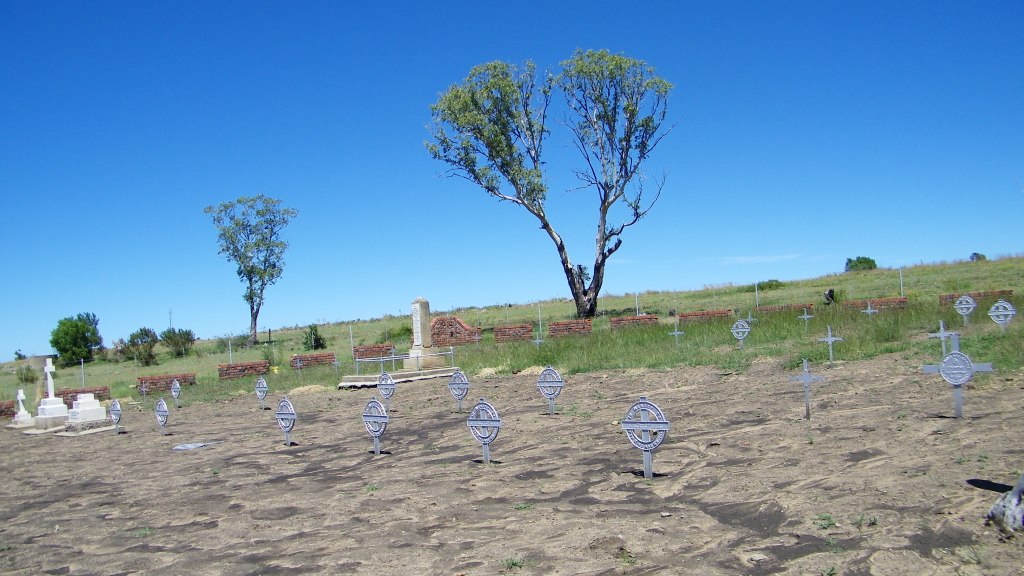
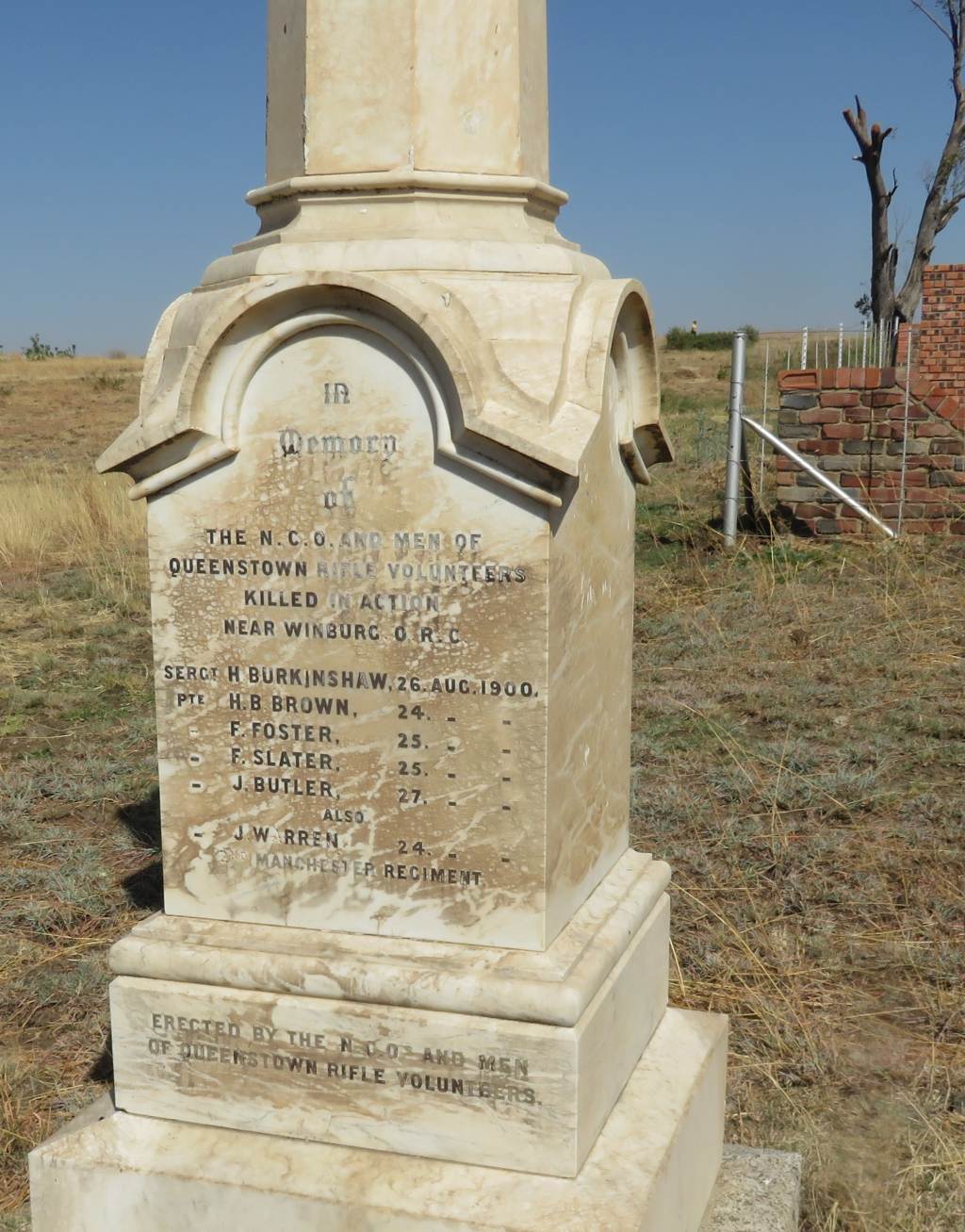 There are two British cemeteries, there is the one in the picture adjacent to the old cemetery at the top of town and then there is the one just below the concentration camp cemetery.
There are two British cemeteries, there is the one in the picture adjacent to the old cemetery at the top of town and then there is the one just below the concentration camp cemetery.
The cemetery down at the concentration camp cemetery is bare, devoid of any iron crosses. They were stolen by, I presume; some scrap collectors. The cemetry near town is still intakt, at least most of the crosses are still there. An interesting grave stone, but not in the British enclosure, is that of some volunteers from the Cape fighting for the British. The inscription reads: In memory of; the N.C.O. and men of; Queenstown rifle volunteers; killed in action; near Winburg O.R.C.; Sergt. H.Burkinshow 26 Aug 1900; Pvt H.P.Brown 24 Aug 1900; Pvt F.Foster 25 Aug 1900; Pvt F.Slater 25 Aug 1900; Pvt J.Butler 27 Aug 1900; also; Pvt J.Warren 24 Aug 1900; 2nd Manchester regiment.
What had happened here? Making it easy on myself I just quote from the Anglo Boer War website:
After Prinsloo had surrendered, the Queenstown Volunteers continued to operate in the Orange River Colony, and in August General Kelly-Kenny issued the following Order, which speaks for itself: "The Lieutenant General commanding the Line of Communications wishes the following incident to be made known throughout his command. Colonel Ridley, Imperial Yeomanry, with about 240 men mostly Colonial Troops, Queenstown Volunteers, while engaged in a reconnaissance north-east of Winburg on August 23rd was cut off and surrounded by 1500 of the enemy with three guns. Ridley and his little force, notwithstanding two days' shelling and rifle fire, and three nights' sniping, held their position until relieved. The enemy twice demanded his surrender without avail. His loss was 30 killed and wounded. The Lieutenant General brings this gallant defence to the notice of his command with the view of showing how a few determined men, skilfully commanded, can hold their own even in an unprepared position, much more so in positions carefully entrenched such as ours". Lord Roberts in his telegram of 26th August also referred to the engagement with satisfaction, and praised the defence. Three of the Queenstown Rifle Volunteers were killed and 14 wounded, including Lieutenant C Smith.
Concentration camp cemetery
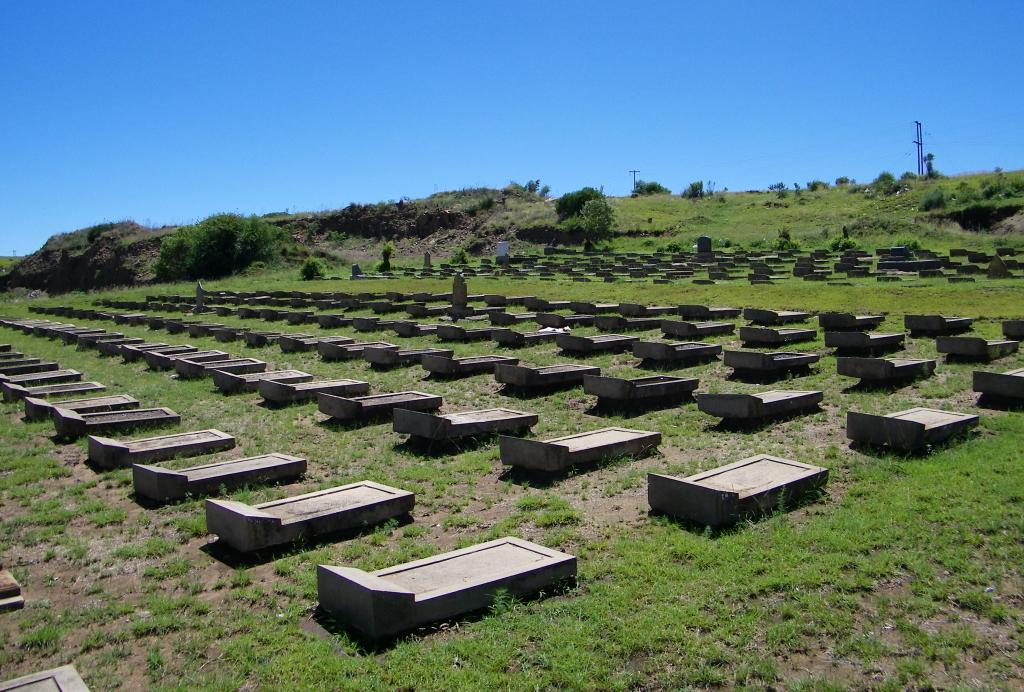
 Over the top of the hill, not easily accessible by car, is the concentration camp cemetery. Winburg had a large concentration camp for the women, children and the old during the Anglo Boer War of 1899-1902. Many of the inhabitants died of the fever, altogether 355 children and 120 adults (source: Wikipedia).
Over the top of the hill, not easily accessible by car, is the concentration camp cemetery. Winburg had a large concentration camp for the women, children and the old during the Anglo Boer War of 1899-1902. Many of the inhabitants died of the fever, altogether 355 children and 120 adults (source: Wikipedia).
A grave of some significance is that of Alice Draper who died at the age of 17 on the 6 January 1902. She featured as a young girl dying of the fever in the book written by Nico Moolman, 'The Boer Whore' (Ref 2). It happened at the beginning of the book and so-to-say set the scene for what was happening around and to the heroine, Susan Nell.
Rietfontein graveyard
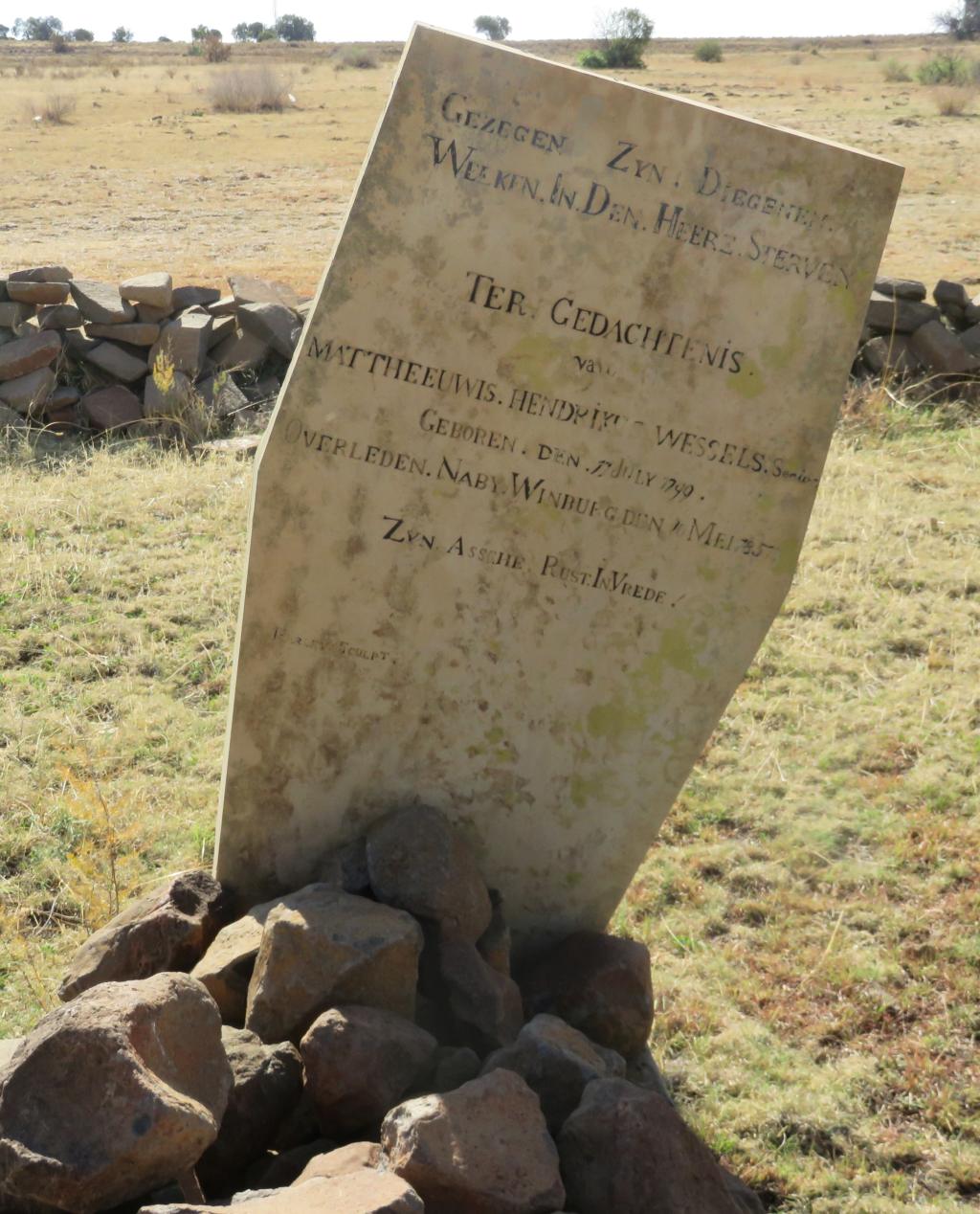 On the road to the Voortrekker monument is a small grave yard containing some very old graves. The oldest I can make out is that of Mattheeuwis Henrikus Wessels, born on the 17 July 1799, died near Winburg on the 10 May 1857. What we know of him is that he and his family came up from the Cape between July 1838 and end of 1839, details are not known. What we also know is that he was a komandant of Winburg.
On the road to the Voortrekker monument is a small grave yard containing some very old graves. The oldest I can make out is that of Mattheeuwis Henrikus Wessels, born on the 17 July 1799, died near Winburg on the 10 May 1857. What we know of him is that he and his family came up from the Cape between July 1838 and end of 1839, details are not known. What we also know is that he was a komandant of Winburg.
Voortrekker Monument
 When in the 1930's it was agreed that there should be a central Voortrekker monument to celebrate the centenary of the Great Trek, Winburg was one of the choices, in the end it lost out to Pretoria. But the idea was not forgotten since Winburg played such a major part as a hub of many treks. Eventually in 1968 it did get it's Voortrekker monument. Although not on the same, large scale as the one in Pretoria.
When in the 1930's it was agreed that there should be a central Voortrekker monument to celebrate the centenary of the Great Trek, Winburg was one of the choices, in the end it lost out to Pretoria. But the idea was not forgotten since Winburg played such a major part as a hub of many treks. Eventually in 1968 it did get it's Voortrekker monument. Although not on the same, large scale as the one in Pretoria.
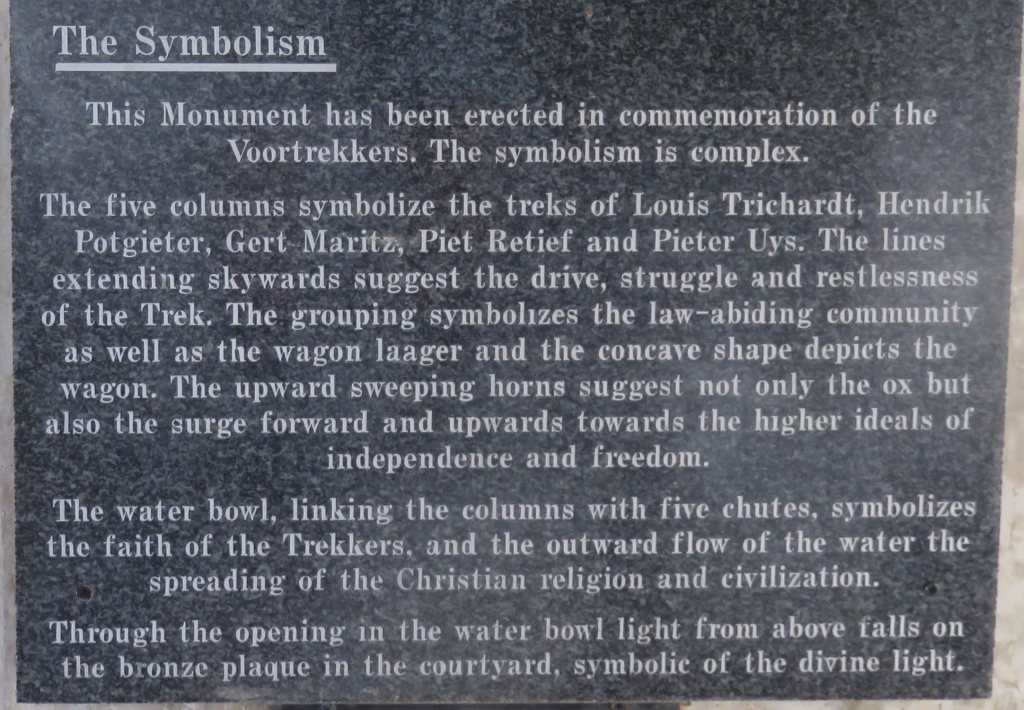 It is a concrete construction of five columns, the symbolism is explained on the plaque, see picture to the right. The bronze plaque mentioned in the last sentence is not there any more, it has been stolen.
It is a concrete construction of five columns, the symbolism is explained on the plaque, see picture to the right. The bronze plaque mentioned in the last sentence is not there any more, it has been stolen.
On a previous visit we found the gate closed and locked, this time it was wide open allowing us access to the monument. 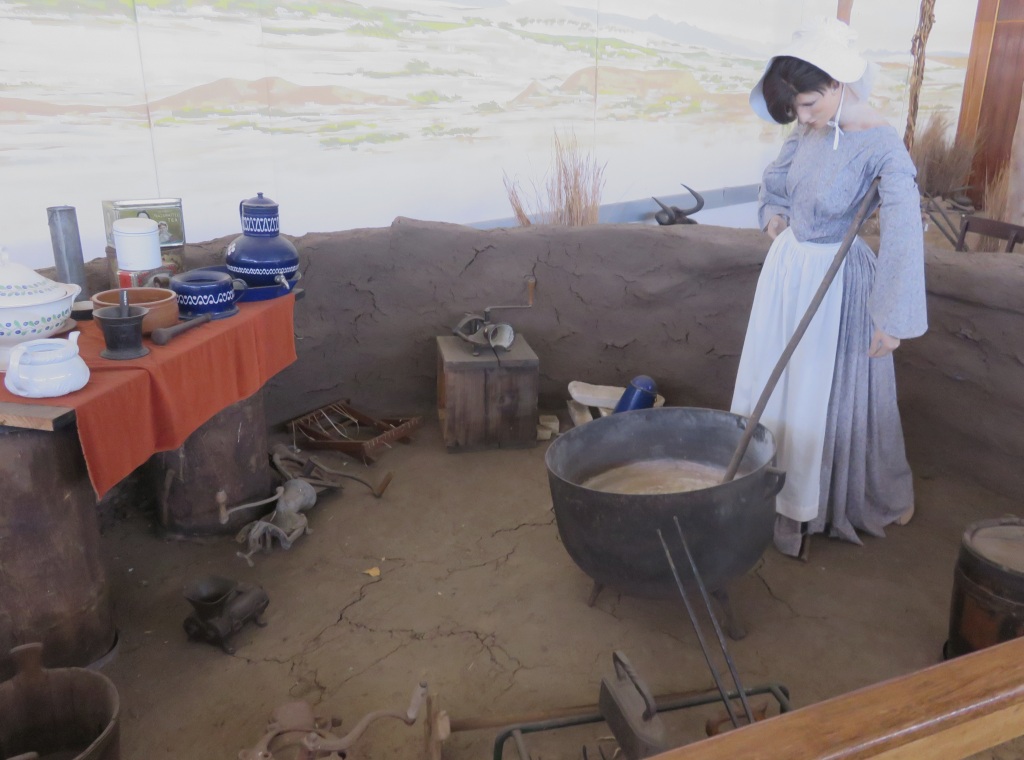 There was one single security guard on duty who signed us in and also opened the museum for us. The place did not look like it was neglected but one can also not say it is well looked after. The concrete of the structure does not look very healthy, there are some cracks exposing the re-enforcing to the weather. Rust is visible at some places.
There was one single security guard on duty who signed us in and also opened the museum for us. The place did not look like it was neglected but one can also not say it is well looked after. The concrete of the structure does not look very healthy, there are some cracks exposing the re-enforcing to the weather. Rust is visible at some places.
The museum is not functional, some of the exhibits have been moved to Bloemfontein, so we were told. It is still worth visiting, it not only concentrates on the lives of the Voortrekkers, but covered everything: fauna & flora, geology and previous habitation. There is a new section, a political addition. It is about the women's struggle against apartheid. 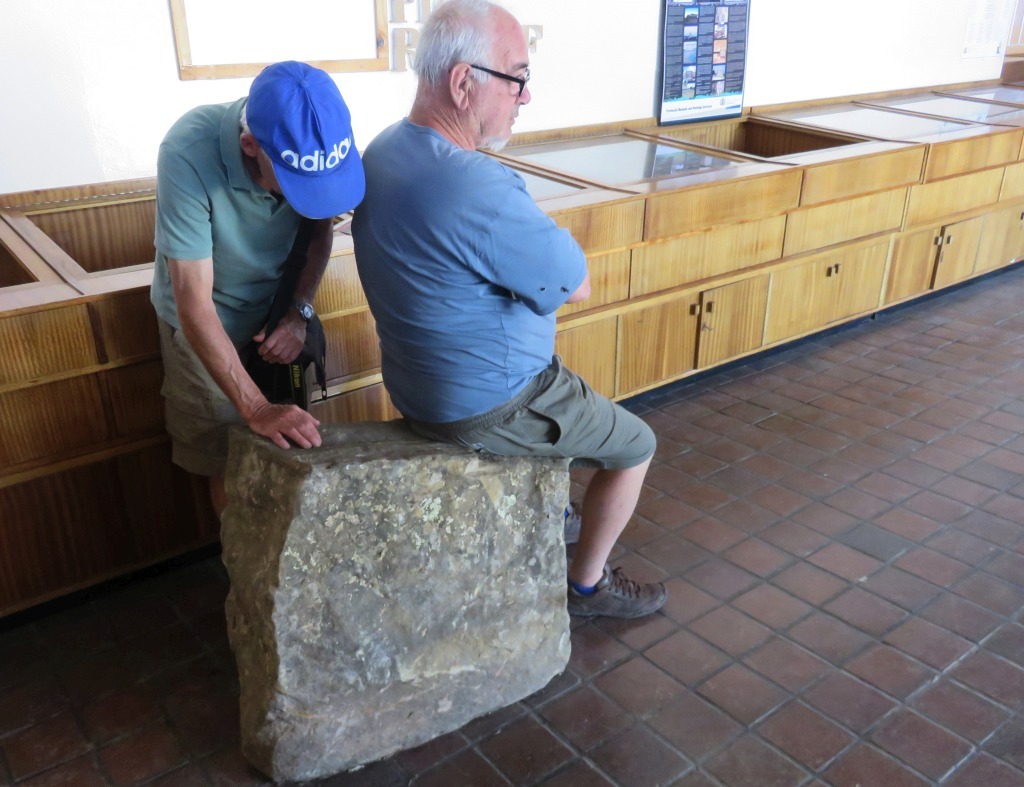
 PS: something I have just discovered, Aug 2020. In the picture on the left, Oliver is sitting on a rock and Frans trying to read the inscription. It reads 1837 P Retief. The rock was originally moved from the farm Blydskap near Kestell where P Retief stayed for a while on his way down to Natal. More about this under Kestell.
PS: something I have just discovered, Aug 2020. In the picture on the left, Oliver is sitting on a rock and Frans trying to read the inscription. It reads 1837 P Retief. The rock was originally moved from the farm Blydskap near Kestell where P Retief stayed for a while on his way down to Natal. More about this under Kestell.
Steyn house
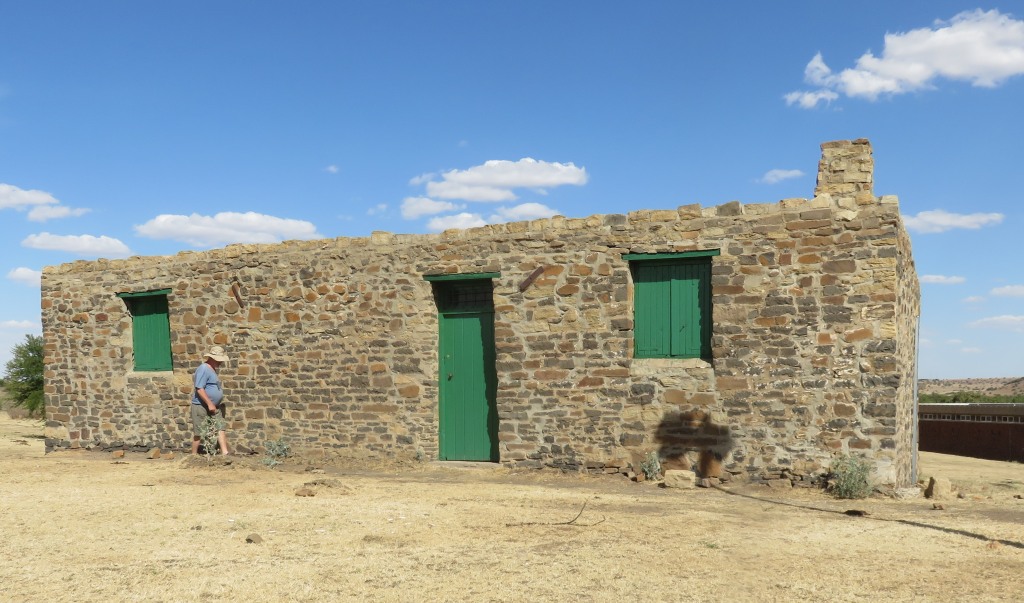
 Near the museum is the Steyn house, it is the birthplace of Marthinus Theunis Steyn, the later president of the Orange Free State. Shortened known as MT Steyn, he was president of the Free State from 1896 to 1902.
Near the museum is the Steyn house, it is the birthplace of Marthinus Theunis Steyn, the later president of the Orange Free State. Shortened known as MT Steyn, he was president of the Free State from 1896 to 1902.
The house is a typical farmhouse of the time, consisting of a bedroom, a kitchen and a lounge. It was declared a national monument in 1952 and kept in a good state. It is furnished in the style of the time and there is a collection of various items used in the kitchen and for general living.
Railway station
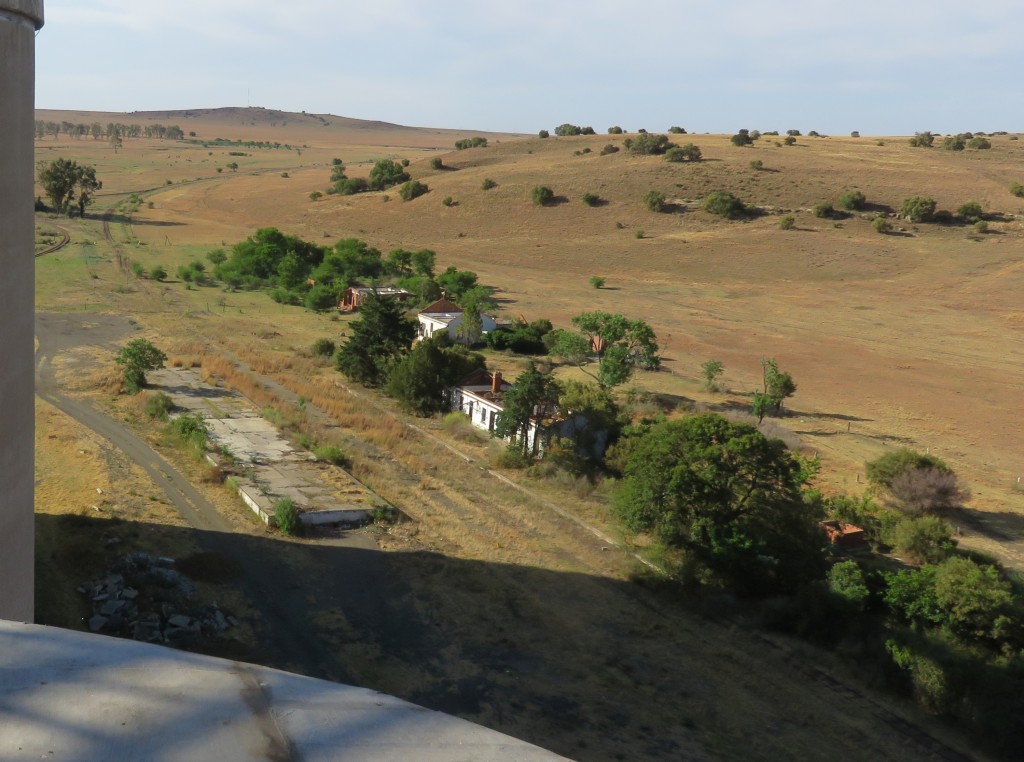
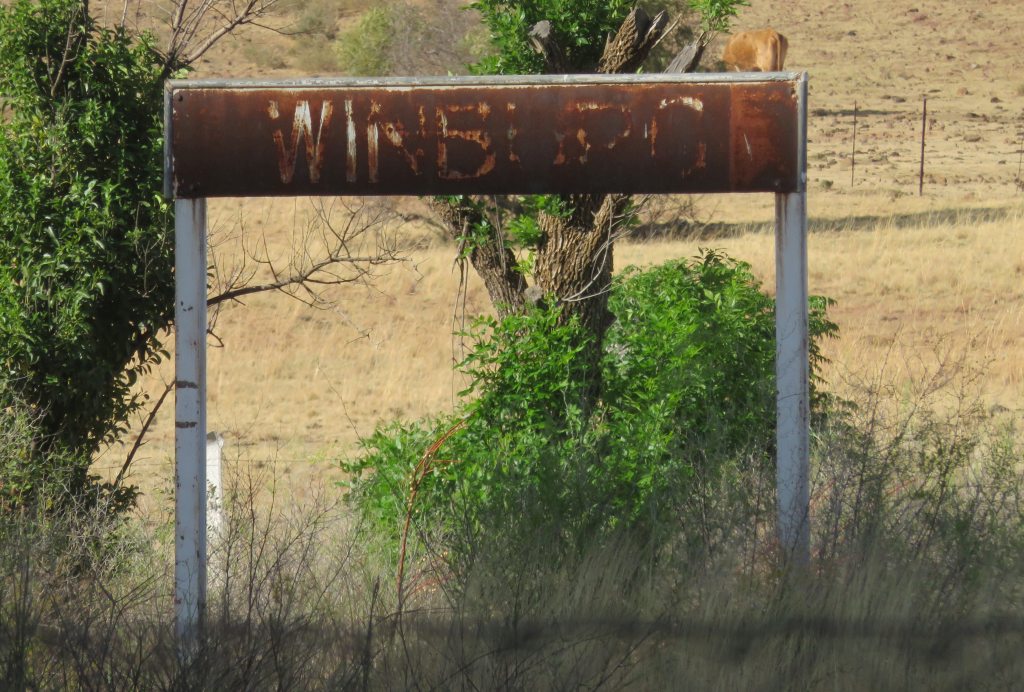 Winburg is at the end of a branch line that used to come from Theunissen. It was first opened in 1898. I am not sure when it was closed, I have the feeling it was in the nineties when the railway was rationalising their service. The picture shows the station and some of its buildings taken from the top of the silos.
Winburg is at the end of a branch line that used to come from Theunissen. It was first opened in 1898. I am not sure when it was closed, I have the feeling it was in the nineties when the railway was rationalising their service. The picture shows the station and some of its buildings taken from the top of the silos.
Various Buildings in town
Townhall
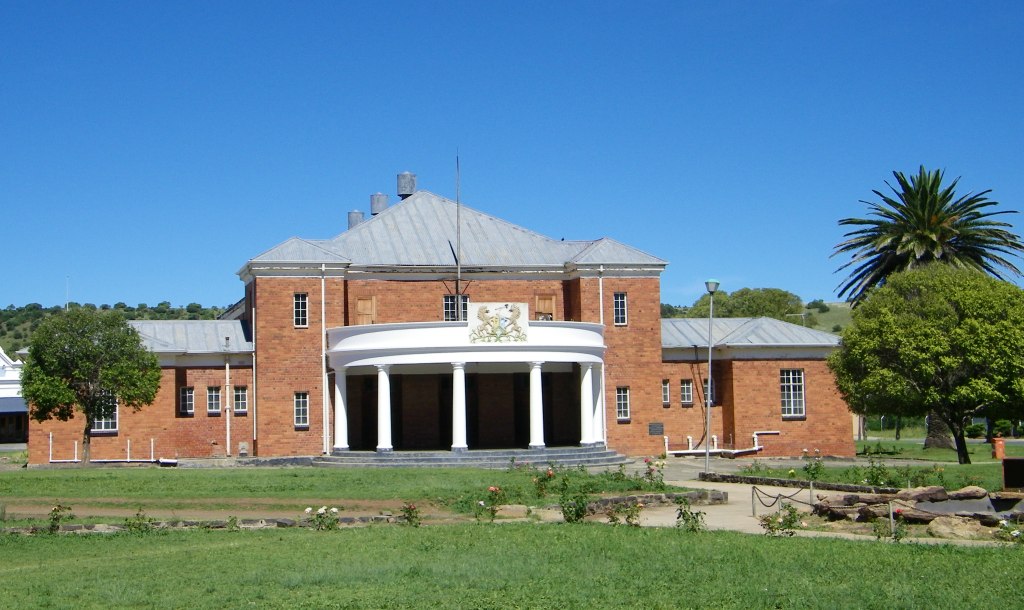
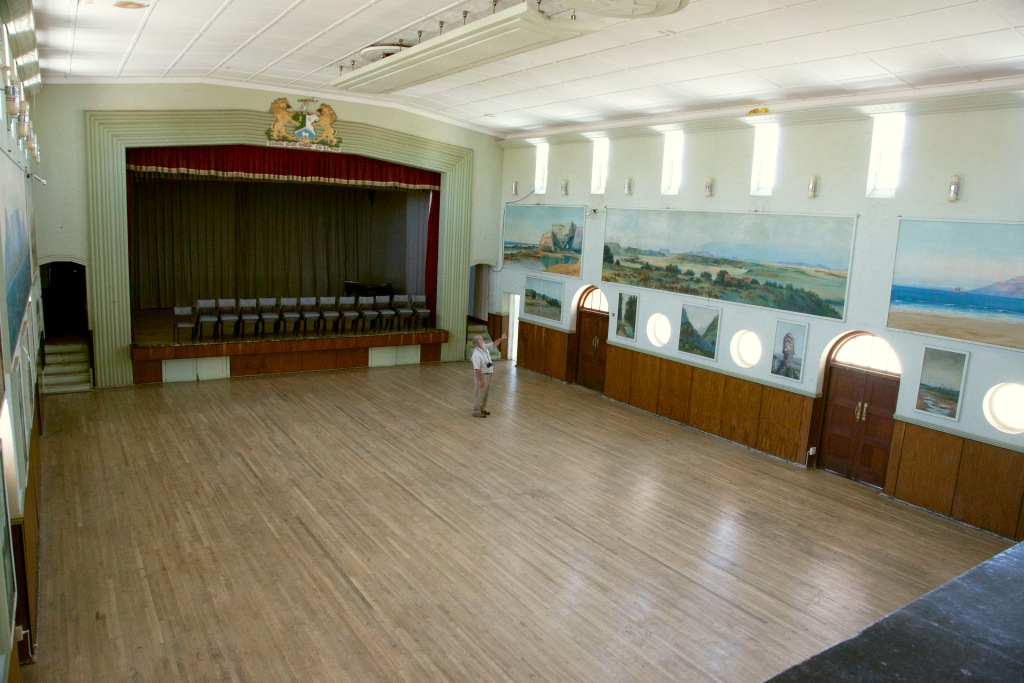 On the same square at the eastern side is the town hall. According to the corner stone it was started in 1938, thus a relatively new building. It is not in use any more, except a section on the side being used as a clinic. Of interest are the painting around the perimeter of the hall on the inside. They all depict pleasing landscape scenes of South Africa.
On the same square at the eastern side is the town hall. According to the corner stone it was started in 1938, thus a relatively new building. It is not in use any more, except a section on the side being used as a clinic. Of interest are the painting around the perimeter of the hall on the inside. They all depict pleasing landscape scenes of South Africa. 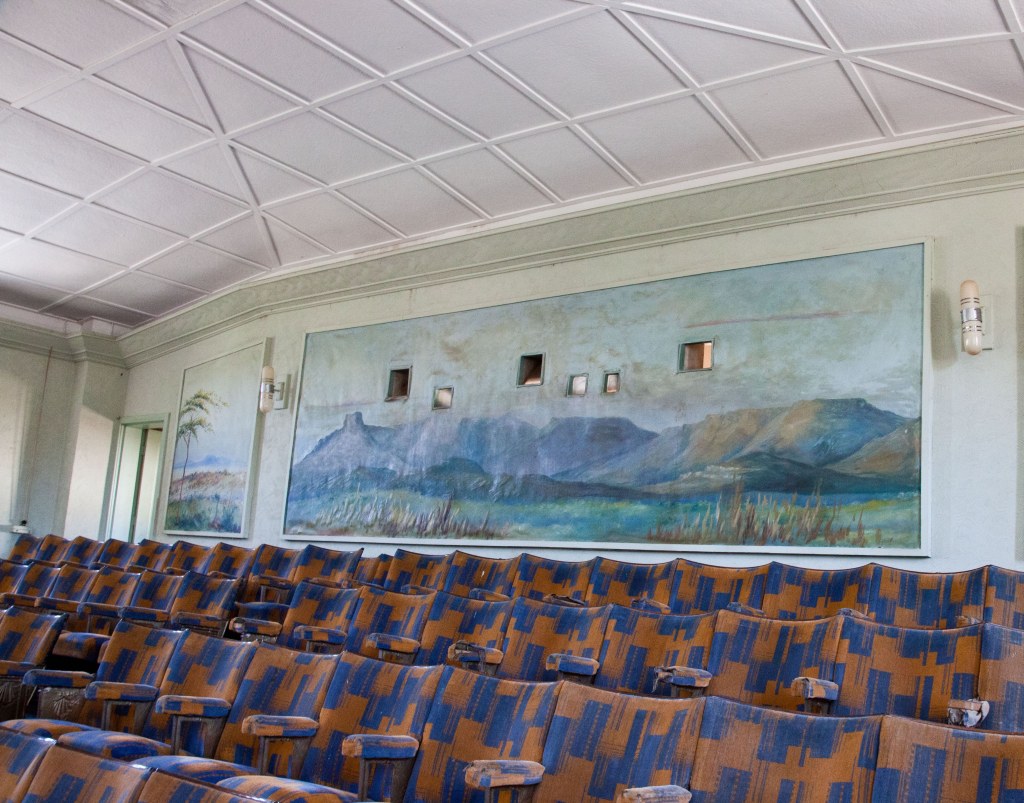 The hall also doubled up as a cinema in the olden days, as can be seen by the projector openings at the back.
The hall also doubled up as a cinema in the olden days, as can be seen by the projector openings at the back.
The person in the picture is me pointing at one of the paintings, the two inside pictures are by my friend Colin R-S.
Pastorie
 Pastorie is a very fitting word to describe the house where the pastor lives, in English it would be a rectory. The information about the building comes from the heritage portal, an article by Grant Hendrey with the title: 'The history of the oldest continually lived in house North of the Orange River'. in my opinion the title of the article is not 100% correct. The house was built in 1851 for the first appointed pastor (minister) to the Winburg NG church, Ds Dirk van Velden, he had come from Holland. The structure had a problem with damp, to cure it the house had to be taken down stone by stone to be rebuild on higher foundations, that was 1884.
Pastorie is a very fitting word to describe the house where the pastor lives, in English it would be a rectory. The information about the building comes from the heritage portal, an article by Grant Hendrey with the title: 'The history of the oldest continually lived in house North of the Orange River'. in my opinion the title of the article is not 100% correct. The house was built in 1851 for the first appointed pastor (minister) to the Winburg NG church, Ds Dirk van Velden, he had come from Holland. The structure had a problem with damp, to cure it the house had to be taken down stone by stone to be rebuild on higher foundations, that was 1884.
Hotel
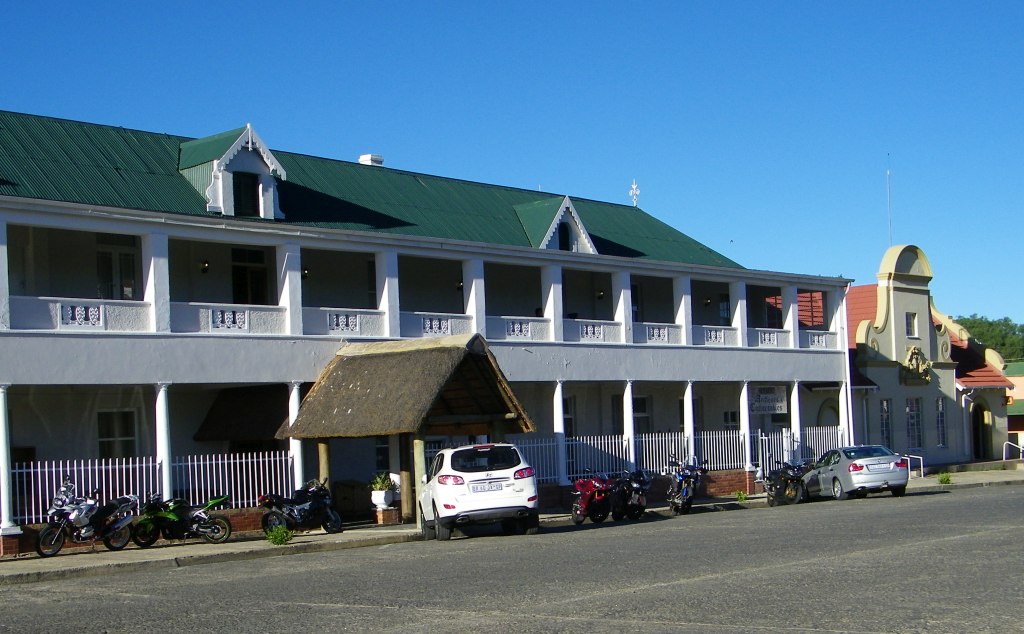 The inscription above the main entrance states the year it was build as 1867. It is still functioning, known as the Winburg Herberg Hotel.
The inscription above the main entrance states the year it was build as 1867. It is still functioning, known as the Winburg Herberg Hotel.
Winburg personalities
Friederig Peter Schnehage
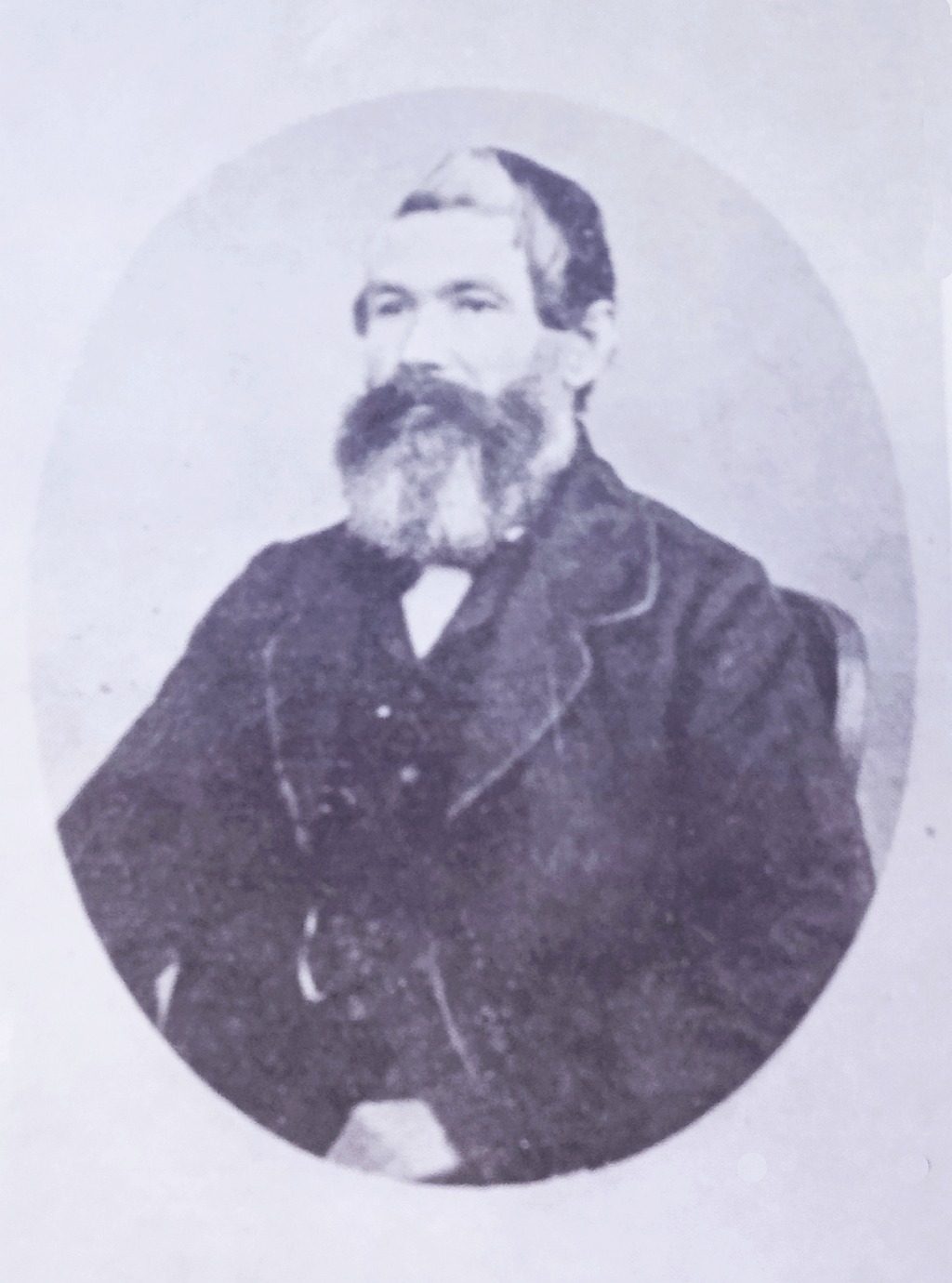 The most dramatic event in his life must have been when the governor of the Cape, Sir Harry Smith, was going to have him hung from a suitable tree in church square in Winburg, that was 1848. How did it come to that?
The most dramatic event in his life must have been when the governor of the Cape, Sir Harry Smith, was going to have him hung from a suitable tree in church square in Winburg, that was 1848. How did it come to that?
FP was born in Hamburg Germany 1811. He came to South Africa in the early 1840th and settled in Winburg 1844. Here he established a trading store and also helped out with the administration by being a secretary to the local landros (magistrate), Willem Jacobs. Very quickly he associated himself with the cause of the Boers against the British claim over the territory.
After the battle at Boomplaats between the British forces and Boers, the governor of the Cape, Sir Harry Smith, marched into Winburg. It is not clear what exactly happened, FP was taken prisoner, he was accused, rightly or wrongly, of supplying guns and ammunition to the Boers at Boomplaats. Apparently Sit Harry Smith was furious and threatened to make an example of FP by hanging him from a suitable tree in church square. It was through the emotional pleading of the beautiful wife of FP that the governor relented and changed the sentence to £200. FP had enough friends that his wife managed to collect this money in a very short time.
In addition to that two prominent inhabitants of Winburg, PA and W Venter, supplied the capital to enable him to expand his business. He became a well known, and successful, businessman of the district. And got involved in politics in the Free State. His was one of the signatures on the document from the Bloemfontein convention that gave the Free State back to the Boers in 1854. He represented Winburg in the Volksraad (parliament) and at one point was one of three committee members that took the responsibility of the president when president Brand was incapacitated through illness.
He died in 1888, leaving behind an empire of a number of farms. He was survived by his wife and the mother of his children, Margerethe Henrietta Vradelmina, who lived to 1909 when she was 87. There was a bit of a complication around his last will. His first daughter was Martha Margareta, born 2 March 1843. She married a medical doctor, James Gibson, but did this without her father's consent. Dr.James Gibson was the first medical practitioner who settled in Winburg. It is assumed that FP did not approve of the marriage because the doctor was a Englishman, actually he was Scottish. They did get married in 1861, because of this FP excluded her and her children from the inheritance. In addition one day before he died he had a section added to the will which also excluded Martha's grandchildren from the inheritance.
Most of the information I gathered from two pages of a website by Dr Albie Gibson, the page about FP Schnehage and Nathaniel Schnehage.
References
Ref 1.: Standard Encyclopedia of Southern Africa, Nasou Limited, 1974
Ref 2.: Nico Moolman, 'The Boer Whore', ISBN-13: 9780620496605, 2012